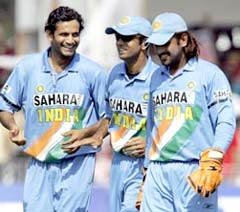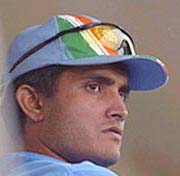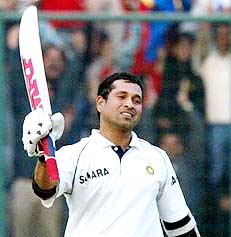|
|
| Help | |
| You are here: Rediff Home » India » Cricket » PTI » Report |
|
| |||||||||||||||||||||||
|
| |||||||||||||||||||||||
The Indian cricket team returned to its winning ways but it was a leaked e-mail and the off-field events it triggered, that dominated the headlines in the year gone by.
Greg Chappell's [Images] feud with Sourav Ganguly [Images] and the latter's ensuing ouster as captain and player, combined with the end of Jagmohan Dalmiya as kingmaker in the intriguing world of BCCI, overshadowed what was otherwise a memorable year.
 Guided by Chappell's mantra of 'Commitment to Excellence', the Indian team recorded stunning victories in the latter part of 2005 to rise to number two in Test rankings and retain its fifth place on the ODI ladder.
Guided by Chappell's mantra of 'Commitment to Excellence', the Indian team recorded stunning victories in the latter part of 2005 to rise to number two in Test rankings and retain its fifth place on the ODI ladder.
Dravid proved himself to be an astute captain within a short time of taking over the reins, Sachin Tendulkar [Images] recovered from a career threatening elbow injury to record his 35th Test century, Anil Kumble [Images] wheeled his way to 100th Test, Irfan Pathan [Images] answered India's search for an all-rounder, and Mahendra Singh Dhoni [Images] emerged as the new Master Blaster.
But, instead of robust optimism it is with a sense of anxiety that the team and the fans will anticipate 2006.
The spat between Ganguly and Chappell was the first major crisis to rock Indian cricket since the match fixing scandal five years ago.
The Board's subsequent handling of the issue and the national selectors' flip-flop on Ganguly's selection only aggravated the wounds.
2005 would be the worst chapter in Ganguly's career book. First he was banned for six matches, later reduced to four, for the team's slow over-rate against Pakistan, and then was involved in an ugly spat with Chappell by saying in public that the coach wanted him to step down as captain.
That revelation came as a bombshell on the tour of Zimbabwe and marred the 2-0 series win, the team's first outside the subcontinent since 1986.
His laborious century from six hours at the crease against a club-level bowling attack was of no help to his cause and his citing symptoms of tennis elbow to skip the domestic Challenger Series provided the selectors with an excuse to omit him from the one-day side.
 Ganguly, riding on a couple of centuries in domestic cricket, retained his place in the Test side against Sri Lanka [Images], but after playing valuable knocks in the second match was dropped from the team for the third Test.
Ganguly, riding on a couple of centuries in domestic cricket, retained his place in the Test side against Sri Lanka [Images], but after playing valuable knocks in the second match was dropped from the team for the third Test.
And when everyone thought it was curtains down on his chequered career, the Prince of Kolkata was included in the squad for the Pakistan tour.
That decision to reinstate him had more to do with the politicisation of the BCCI rather than a change of heart from the selectors.
That politics had taken over the Board was referred to by none other than Jagmohan Dalmiya himself. His statement came a few days after his nominee and incumbent Ranbir Singh Mahendra lost the President's post to Union Agriculture Minister and Mumbai Cricket Association Chief Sharad Pawar [Images].
Though Pawar did not contest the elections, the defeat was very much seen as Dalmiya's, as he made all the moves from behind.
It marked the end of an era which saw India become the power centre of world cricket and the prime source of finance to run the game.
Chappell on the other hand could be credited with getting the team back to its winning ways after the acrimonious Zimbabwe tour.
A 6-1 thumping in the one-dayers followed by a 2-0 drubbing saw India extend their home domination over Sri
Lanka. In between, the team held a resurgent South Africa 2-2 in a five-match limited overs series.
The 57-year-old former Australian captain put team success ahead of individual milestones and the strict fitness regime introduced by his support staff paid dividends shortly.
Chappell considered players who bring multiple values and who have the flexibility to perform different roles as assets to the team.
So, while Ganguly, Ashish Nehra and Zaheer Khan [Images] were left out despite their past record, those like Virender Sehwag [Images] and Yuvraj Singh [Images] were given a long rope even though their current form was in a downward curve.
Yuvraj repaid the coach's faith soon but the player to take wings under Chappell's guidance was Pathan.
The Baroda player soared a few notches and that too with his batting skills. His demolition act in the first one-dayer at Nagpur set the tone for India's domination of Sri Lanka and he rounded off the year with scores of 93 and 82 in the Test series.
Dhoni confirmed his talent with a belligerent 183 in the third one-dayer against Sri Lanka. So overwhelming was his performance that the selectors had no hesitation in inducting him into the Test team as well.
 Tendulkar overcame a traumatic five-month injury layoff to surpass former captain and compatriot Sunil Gavaskar [Images] for most number of Test centuries with his 35th ton in the second match against Sri Lanka in New Delhi.
Tendulkar overcame a traumatic five-month injury layoff to surpass former captain and compatriot Sunil Gavaskar [Images] for most number of Test centuries with his 35th ton in the second match against Sri Lanka in New Delhi.
The world's leading batsman silenced his critics with a belligerent knock in the first ODI against the Lankans but it was in the new role of 'mentor' that the team and fans will be seeing him more in the days to come.
Kumble became the fifth Indian to play in 100 Tests in the third match against Lanka. The 35-year-old leg-spinner ended the year with 41 wickets from eight matches to extend his career tally to 485.
Harbhajan Singh [Images] put aside his initial outburst against Chappell and redeemed himself as one of the best off-spinners on the scene with wickets and economical bowling spells in the latter part of the year.
His redemption at the end of the year was a far cry from the start of 2005 when he was reported for suspect action for the second time inside 12 months and faced a one-year ban.
All the while, Dravid led from the front. If he proved his cricketing nous by setting attacking field placements or juggling the bowling options, he scored runs at will to provide batting stability.
In the winter weather of Feroze Shah Kotla, venue of the second Test, he braved a viral infection to open the batting in Sehwag's absence.
As fate would have it, the virus laid him down for the final Test, denying him a rare record of playing in 100 consecutive Tests since debut.
But Dravid did manage to get one record under his belt: he became only the third Indian to reach 8,000-run mark after Tendulkar and Gavaskar in the Kotla Test.
The reward for Dravid, and an indication of where the selectors, was him being appointed as captain for the whole season covering the tour of Pakistan and home series against England [Images].
The revival of team's fortunes set the Board's cash register ringing. The new team sponsorship contract fetched more Rs 650 crore, making the Indian team the most valued sporting outfit in terms of sponsorship revenues in the world ahead of several European football clubs.
It is a picture could have been possible only in the realms of fantasy at the start of the year when the team allowed Pakistan to comeback from behind to draw the three-Test series 1-1 and then suffered a humiliating 2-4 loss in the one-dayers.
On the domestic front, Railways won the Ranji Trophy for the second time in four years and the champions lifted the Irani Cup without much ado.
Photographs: Getty Images
| © Copyright 2008 PTI. All rights reserved. Republication or redistribution of PTI content, including by framing or similar means, is expressly prohibited without the prior written consent. |
|
|
| © 2008 Rediff.com India Limited. All Rights Reserved. Disclaimer | Feedback |